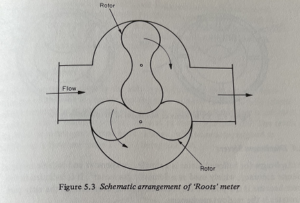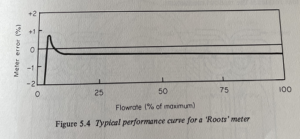How they work
In principle, positive displacement meters for gases should be similar to those used for liquids as described in section 5.1.1 above, and share their advantages and disadvantages. However, in practice, there is one very important difference. The energy in a flowing fluid is proportional to its density, and this means that a gas cannot easily supply sufficient power to operate a complex mechanical meter. Consequently, positive displacement meters for gases have to have a very low frictional resistance, and this requirement leads to some interesting variations in design.
The main types of positive displacement meters for gases are described separately, below.
The roots meter
The proprietary roots meter is, in effect, a gear-type meter in which low frictional resistance is obtained by using lightweight meshing rotors of figure-of eight shape2, as shown schematically in Figure 5.3.
Its performance curve, Figure 5.4, follows the familiar pattern of positive displacement meter curves, with slip at low flow rates causing a sudden fall in the curve. The rangeability is around 20:1, with good linearity over most of this range. Accuracies of ±0.5% can be obtained.
Meters of this type can be obtained to cover flow rates up to 2m3s-1 and pressure up to 80 bar, although they are rarely used at pressures above 10 or 20 bar because of the great weight of high-pressure models. The performance is little affected by upstream flow disturbances or distorted velocity profiles3, but the roots meter is adversely affected if severe pulsations are present in the flow reaching it4.
Its main drawbacks are that it introduces cyclic pulsations into the flow and that it cannot tolerate dirt so that filters must be installed upstream.


